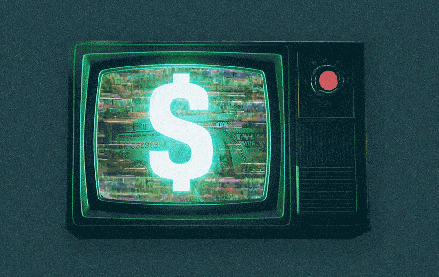Future of TV Briefing: The ad product OpenAI should introduce in Sora (I’m sorry)

This Future of TV Briefing covers the latest in streaming and TV for Digiday+ members and is distributed over email every Wednesday at 10 a.m. ET. More from the series →
This week’s Future of TV Briefing looks at how OpenAI could create a commercial version of Sora’s Cameos feature that could thread the needle between a sponsored product, affiliate commerce and a revenue-sharing program for creators.
- Sora’s Sponsored Stories
- Netflix’s Spotify deal, Instagram’s CTV app, brands’ AI influencer disinterest and more
Sora’s Sponsored Stories
The most obvious ad product for OpenAI to introduce to its AI-generated video platform Sora would be in-feed ads. But that’s boring. And besides, OpenAI has an opportunity to introduce a way more native ad placement that threads the needle between brand awareness and affiliate marketing with a twist of dystopia.
I’m talking about AI-generated virtual product placements.
Think about it: With Sora, people are having OpenAI create their posts for them, which means OpenAI is in position to put whatever it wants in those AI-generated videos. That can include ads in the form of branded products, like a basketball featuring Nike’s logo when a user’s prompt includes the word “basketball.” And considering that OpenAI has already adopted affiliate links in ChatGPT and recently added an Instant Checkout option, it could port those capabilities over to Sora so that someone could purchase said Nike basketball from the AI-generated post.
To be clear, I know this NASCAR-cum-QVC-ification of social videos sounds as horrible as that descriptor. But it was an interesting thought that popped into my head and only piqued my interest further as I thought about it. Because the more I thought about it, the less far-fetched it seems.
But before we go any further: The worst version of this is OpenAI automatically placing branded products and intellectual property in people’s videos without users’ consent (we’ll get to brand consent, don’t you worry). And as much as that is a very real, if entirely dumb possibility, it would be a moronic move, so let’s assume for the purposes of this piece that OpenAI wouldn’t do that and would instead require people to opt in to allow these product placements in their Sora videos.
In other words, Sora’s native ad product would be branded Cameos. With Cameos — Sora’s feature for people’s AI avatars to be incorporated into others’ videos — OpenAI already has the user-facing feature that could be co-opted for commercial purposes (the formula for social ad products ever since Facebook rolled out Sponsored Stories more than a decade ago). And if OpenAI were to proffer these as user-selected branded Cameos, then they’re simply the AI-era descendants of Snapchat’s branded filters.
This may all sound like the ravings of a mad man who watched too much “Mad Men.” And I’ll repeat: I don’t like that this popped into my head, but 14 years of reporting on advertising — what ya gonna do? Anyway, I ran the idea by some ad execs.
“I think that makes perfect sense,” said Hope Horner, CEO and co-founder of video agency Lemonlight. “Because it’s creating content already, and so it makes a lot of sense to incorporate branded content from paid advertisers in order to generate revenue. I think that also introduces some other challenges from an IP and just like a licensing standpoint. And like, what if the Nike ball spells ‘Niku’ instead of ‘Nike?’”
Definitely a cause for concern. But not the biggest one, not by a longshot.
“They will need tight guardrails,” said Richard Swain, partner at branding agency Further. “If you play it out, brands are reluctant to advertise on Twitter out of fear of what they’ll be surrounded by, right? So this is almost like tenfold.”
Sora is supposed to have guardrails against “sexual, violent and otherwise harmful content,” according to The Washington Post. (Of course so does just about every other major social platform, so tub of salt).
But using the existing Cameos feature as the foundation, Sora already allows people to see every post made by someone using that person’s Cameo and for people to report posts featuring their Cameo and have those posts taken down. To what extent OpenAI is reliably and expediently handling those requests is anyone’s guess, but I would guess if the person doing the reporting is a brand spending millions of dollars with the company, which really needs the money, the company would handle the requests posthaste.
An alternative to making these branded Cameos open to anyone and everyone would be using the existing Cameo controls so that a brand can limit who can use a branded Cameo to an approved set of users, such as oh I don’t know creators/influencers. This would not only address the brand safety concerns, but it could also create a revenue-sharing product for OpenAI to attract creators and even spawn a wave of what my colleague Seb Joseph has brilliantly dubbed “vibe creators” (the level of dystopia in this piece…). That revenue cut could come from simply using the branded Cameo or be based on the number of impressions the creators’ posts receive or the number of product sales their posts generate if OpenAI goes the affiliate link route.
Alternatively to that alternative, a brand could open up its branded filter to a larger set of users but within a somewhat strict context.
“What if you did a prompt challenge or a co-creation contest, like generate your own Nike-branded basketball. Something that’s a little bit more protected or gated or even like what you were saying with Snapchat brand filters. Brands provide tools or asset libraries that users can specifically leverage,” said Swain.
I’ll keep saying it: I know this sounds like shrinking the world’s water supply to sell ads (it does) and aren’t there better things for me to be spending my time on (there are). But I can’t shake the feeling that some version of this is in the offing and that I’m far from the only person thinking about this. Because if it’s not on Sam Altman’s mind, I’m guessing it is on Fidji Simo’s — and Mark Zuckerberg’s.
What we’ve heard
“The short-term algo fuckery is real. Noise is going to drown out the signal for a minute. But us humans happen to sport evolution’s most finely tuned bullshit detector.”
— Lore Machine’s Thobey Campion on the prevalence of AI slop in social feeds
Numbers to know
$20: Price per share that Paramount reportedly offered to pay to acquire Warner Bros. Discovery, an amount the latter considered too low.
70%: Base percentage of subscription revenue that TikTok will now allow creators to keep, up from 50%.
90%: Percentage share of U.S. parents with a kid 12 years old or younger who said the child watches videos on a TV screen, compared to 61% for phone screens.
What we’ve covered
The Sora-TikTok U.S. era of short-form video:
- Carving out a smaller U.S.-only version of TikTok puts the platform’s grip on audiences and advertisers at risk.
- Another risk is people’s attentions shifting toward AI-only video feeds like OpenAI’s Sora and Meta’s Vibes.
Listen to the latest Digiday Podcast episode here.
The creator is splintering as AI forces a new reckoning:
- Creators are having to decide between adopting or rejecting generative AI technologies.
- The prevalence of AI slop is heightening the stigma around using AI to make content.
Read more about creators and AI here.
Brand advertisers find awareness-boosting niche for interactive and shoppable CTV formats:
- Fubo’s revenue from interactive and shoppable ads has increased by 217% year over year.
- Ad agency Moroch’s clients’ spending on interactive CTV ads has increased by 17% year over year.
Read more about CTV ad formats here.
Sora’s promise — and peril — for the creator economy:
- Sora has introduced the concept of “vibe creator,” i.e. people who use AI to create videos.
- The rise of vibe creators is likely to spur a change in the nature of parasocial relationships.
Read more about OpenAI’s Sora here.
Tubi hopes emotional context can drive demand for streaming’s long tail:
- Tubi is working with IRIS.TV to tag programming on its platform for contextual ad targeting.
- The companies will tag the programming based on emotional and thematic categories, such as “joyful” and “travel.”
Read more about Tubi here.
What we’re reading
The streaming service will distribute 16 video podcasts from Spotify starting next year in a direct move by Netflix to cut into YouTube’s video podcast dominance, according to The New York Times.
The Meta-owned platform that probably still owns the IGTV trademark is thinking about rolling out a CTV app but isn’t looking to license live sports programming, according to Bloomberg.
Brands’ AI influencer disinterest:
The number of brand deals between brands and AI influencers has declined by 30% year over year in 2025, thanks to a combination of audience blowback against AI creators and AI creators’ branded content underperforming, according to Business Insider.
Twitch’s top streamers, Cenat has 19 million followers on the platform, brand deals with Nike and McDonald’s and eyes on being the next creator turned media mogul with plans to form a production company, according to The New York Times.
Want to discuss this with our editors and members? Join here, or log in if you're already a member.
More in Future of TV

Programmatic agency execs speak out on CTV transparency
At the recent Digiday Programmatic Marketing Summit, agency executives spoke out — on stage and in behind-closed-door town hall sessions — on how they see transparency in CTV.

Future of TV Briefing: How agencies are setting up their programmatic teams for the agentic AI era
This week’s Future of TV Briefing recaps two sessions from last week’s Digiday Programmatic Marketing Summit about how agencies’ programmatic buying teams are evolving.

Future of TV Briefing: The streaming ad upfront trends, programmatic priorities revealed in Q3 2025 earnings reports
This week’s Future of TV Briefing looks at what TV and streaming companies’ latest quarterly earnings report indicate about the state of the streaming ad market.






